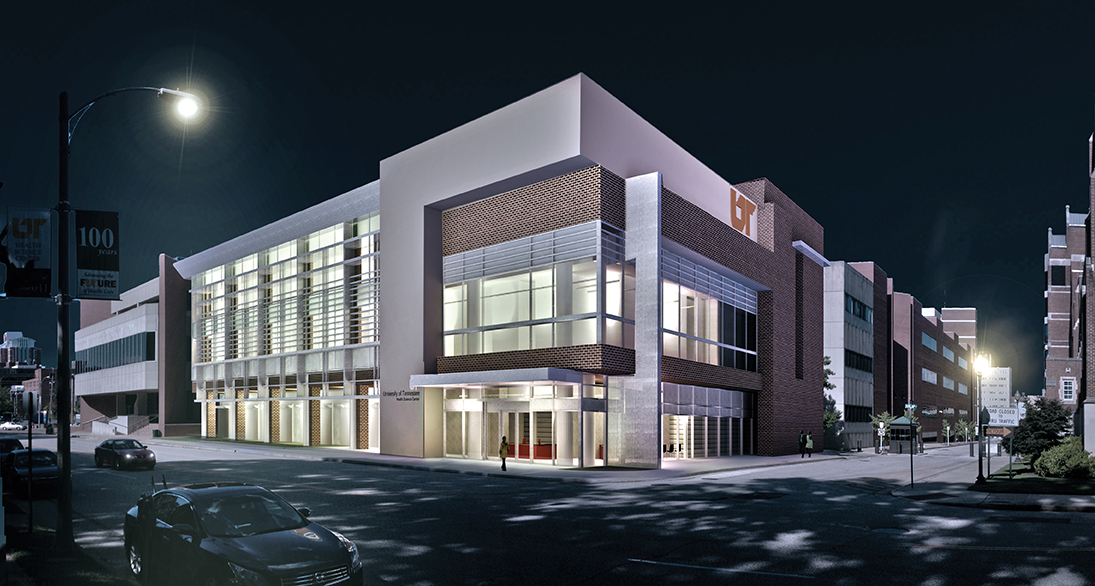
 Continued from … Bridging the Gap
Continued from … Bridging the Gap
The future of health care education is emerging in the heart of the UTHSC campus.
When the new $24.1 million, 45,000-square-foot Multidisciplinary Simulation Building, going up in the footprint of the obsolete Feurt Pharmacy Research Building at 26 S. Dunlap Street, is finished in the summer of 2016, UTHSC will stand at the forefront of inter-professional education alongside other comprehensive academic health science centers of its size across the country and beyond.
“All of our health professions are looking for more active ways of engaging their students in general. Students are expecting more hands-on work, and they are doing a lot more team-based learning,” said Alicia Dorsey, PhD, associate vice chancellor, Academic Affairs.
“It is expected that students have the opportunity to train in simulation environments,” Dr. Dorsey said. “It used to be a luxury, a unique feature of a program. Now it’s expected.”
The new three-story building provides more room for state-of-the-art simulation training within professions and in teams, bringing together students in various professions. It also consolidates the training mainly under one roof, instead of across campus as it is now.
“There’s a fair amount of evidence that suggests that with students who are trained in simulation centers before they go out and actually are in the health workforce, there is a higher level of confidence as they’re interacting with patients, higher patient safety, and higher quality of care because they have practiced in a safe, simulated environment repeatedly,” Dr. Dorsey said. “So when they actually are faced in a real setting with some of the things they trained on, it’s not the first time they’ve seen it.”

The new building is designed by brg3s architects of Memphis, which has done new design and redesign work on a number of buildings on the UTHSC campus. Oregon-based SimHealth Group, an internationally known and highly skilled consulting firm that has designed simulation centers all over the world, has also been engaged to guide the campus leadership team and steering committee on design, curriculum, implementation and faculty development to maximize the space and use of the building.
The new building “brings us really up to date,” said George Maish, MD, clinical director of Inteprofessional Education and Clinical Simulation and an assistant dean of Student Affairs in the UTHSC College of Medicine. It expands and enhances current simulated training capabilities available in the Kaplan Clinical Skills Center and the Interprofessional Education and Clinical Simulation Center (IPECS) on campus. It will be a major attraction in recruiting the best and brightest students and residents in the future, he said.
Step Inside
The first floor of the building will host fundamental skills-training opportunities. Two skills rooms, each with 12 hospital beds around the outside of the room and a training table in the center, will provide an environment to learn, practice and test basic exam and clinical skills. This floor will also have large, multi-purpose training rooms, and a home environment with a kitchen area, living room and bathroom to facilitate training for anyone who will be visiting a home to provide patient care.
The second floor will house specialized environments, including simulated hospital rooms, a neonatal intensive care unit, a birthing suite and an operating room, all of which are designed to be flexible enough to be configured as needs dictate.
The third floor will have a community pharmacy area and 24 outpatient clinical rooms.
All three floors have debriefing rooms where instructors can critique student performance, small group rooms and administrative space. The building also has lounge, training and prep space for standardized patients, actors trained under standardized protocol to portray patients.
Additional high-fidelity manikins, computerized replicas of patients, will be available for student training, expanding the work being done at IPECS. The manikins represent patients across the age spectrum.
Looking Ahead
The facility is also being designed to accommodate continuing education for existing health professionals, to serve as a resource for the residency programs affiliated with the College of Medicine, and for team training for physicians and staff members at partner hospitals.
